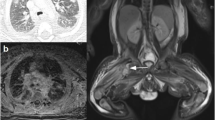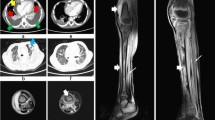Abstract
Objectives
To assess the etiology, precipitating factors, treatment and outcome of disseminated staphylococcal disease (DSD) in healthy immunocompetent children.
Methods
This hospital based observational prospective study was conducted in two tertiary care hospitals of West Bengal, India during the period of March, 2011 through February, 2012. Inclusion criteria were 1) children between 1 and 12 y and 2) clinical features DSD characterized by i) involvement of at least two distant organs with presence of gram positive cocci in clusters and/or growth of Staphylococcus aureus from at least one normally sterile body fluid, ii) fever, persistent bacteremia despite antibiotics and focal involvement of two or more separate tissue sites (skin, bone, joint, kidney, lung, liver, heart).
Results
Thirty six cases fulfilled the criteria of DSD with mean age in years 6.03 ± 3.04 (range 1–12). The age group of 5–12 y was found to be more vulnerable (p < 0.001). Septic arthritis following accidental blunt closed trauma, was the significant precipitating factor for DSD in this age group (p = 0.031). Methicillin resistant Staphylococcus aureus (MRSA) was the causative agent in all the cases. Vancomycin resistant Staphylococcus aureus (VRSA) was detected in 88.9 % of cases. All cases were sensitive to linezolid. No significant side effects were observed with 28 d of linezolid therapy.
Conclusions
DSD is more common in 5–12 y age group. Trauma is a significant precipitating factor for DSD in this age group. Linezolid may be considered as the first line drug in DSD with MRSA.



Similar content being viewed by others
References
Lampe RM. Suppurative Arthritis (Septic Arthritis). In: Behrman R, Kliegman RM, Jeson HB, eds. Nelson Textbook of Pediatrics. Vol. 2. 18th ed. Philadelphia: WB Saunders; 2008. pp. 2846.
Baranwal AK, Singhi SC, Jayashree M. A 5-y PICU experience of disseminated Staphylococcal disease. J Trop Pediatr. 2007;53:245–51.
Todd JK. Staphylococcus. In: Behrman R, Kliegman RM, Jeson HB, eds. Nelson Textbook of Pediatrics. Vol. 1. 18th ed. Philadelphia: WB Saunders; 2008. pp. 1125–7. Table 180–2.
Lampe RM. Osteomyelitis. In: Behrman R, Kliegman RM, Jeson HB, eds. Nelson Textbook of Pediatrics. Vol. 2. 18th ed. Philadelphia: WB Saunders; 2008. pp. 2842.
Aldin AS, Hinz L, Eisele R. Severe complications of Staphylococcus aureus infection in the child. Unfallchirurg. 2001;104:85–90.
Hieber JP, Nelson AJ, McCracken GH Jr. Acute disseminated staphylococcal disease in childhood. Am J Dis Child. 1977;131:181–5.
Ochoa TJ, Mohr J, Wanger A, Murphy JR, Heresi GP. Community associated methicillin resistant Staphylococcus aureus in pediatric patients. Emerg Infect Dis. 2005;11:966–8.
Lin MY, Rezai K, Schwartz DN. Septic pulmonary emboli and bacteremia associated with deep tissue infections caused by community acquired methicillin-resistant staphylococcus aureus. J Clin Microbiol. 2008;46:1553–5.
Kruse BT, Vadeboncoeur TF. Methicillin-resistant staphylococcus aureus septis presenting with septic pulmonary emboli. J Emerg Med. 2009;37:383–5.
French G. Safety and tolerability of linezolid. J Antimicrob Chemother. 2003;51:ii45–53.
Falagas ME, Siempos II, Vardakas KZ. Linezolid versus glycopeptide or beta-lactam for treatment of Gram-positive bacterial infections: Meta-analysis of randomised controlled trials. Lancet Infect Dis. 2008;8:53–66.
Herrmann DJ, Peppard WJ, Ledeboer NA, Theesfeld ML, Weigelt JA, Buechel BJ. Linezolid for the treatment of drug-resistant infections. Expert Rev Anti Infect Ther. 2008;6:825–48.
American Thoracic Society; Infectious Diseases Society of America. Guidelines for the management of adults with hospital-acquired, ventilator-associated, and healthcare-associated pneumonia. Am J Respir Crit Care Med. 2005;171:388–416.
Mandell LA, Wunderink RG, Anzueto A, et al. Infectious Diseases Society of America/American Thoracic Society consensus guidelines on the management of community-acquired pneumonia in adults. Clin Infect Dis. 2007;44:S27–72.
Contributions
KM, AR, TB, SS, NK, SM were involved in management of patients. KM, AR, TB, SS, NK, SM searched the literature. KM and AR drafted the manuscript. KM and AR did the critical review. All the authors approved the final version. All the authors shall act as the guarantor.
Conflict of Interest
None.
Role of Funding Source
None.
Author information
Authors and Affiliations
Corresponding author
Rights and permissions
About this article
Cite this article
Mandal, K., Roy, A., Sen, S. et al. Disseminated Staphylococcal Disease in Healthy Children—Experience from Two Tertiary Care Hospitals of West Bengal. Indian J Pediatr 81, 133–137 (2014). https://doi.org/10.1007/s12098-013-1034-7
Received:
Accepted:
Published:
Issue Date:
DOI: https://doi.org/10.1007/s12098-013-1034-7




